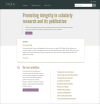Predatory Open Access Journals are Indexed in Reputable Databases: a Revisiting Issue or an Unsolved Problem
- PMID: 33041454
- PMCID: PMC7520066
- DOI: 10.5455/medarh.2020.74.318-322
Predatory Open Access Journals are Indexed in Reputable Databases: a Revisiting Issue or an Unsolved Problem
Abstract
Introduction: Pseudo journals, hijacked journals, fraudulent journals, fake journals, and predatory journals waste valuable research when authors publish their studies in them.
Aim: This article described novel suggested features for the identification of fraudulent journals and aimed to explain this issue to help inexperienced scientists avoid publishing in predatory journals.
Methods: The articles related to this topic in were retrieved from PubMed and trustable Internet sources.
Results: Unfortunately, some fake journals have made their way into reputable databases, such as PubMed, PubMed Central, MEDLINE, SCOPUS, and Web of Science; thus, the serious question has been raised regarding how we should address this problematic phenomenon. We recommended 28 suggested characteristics of predatory journals for readers to take into consideration.
Conclusion: Unaware of the detrimental effects associated with publishing in disreputable journals, inexperienced researchers can fall victim to them. Together, as both readers and writers, we should completely boycott predatory journals.
Keywords: Medline; Predatory journals; Pubmed; Pubmed Central; SCOPUS; Web of Science.
© 2020 Nguyen Minh Duc, Dang Vinh Hiep, Pham Minh Thong, Lejla Zunic, Muharem Zildzic, Doncho Donev, Slobodan M. Jankovic, Izet Hozo, Izet Masic.
Conflict of interest statement
There are no conflicts of interest.
Similar articles
-
Predatory Publishing in Orthopaedic Research.J Bone Joint Surg Am. 2018 Nov 7;100(21):e138. doi: 10.2106/JBJS.17.01569. J Bone Joint Surg Am. 2018. PMID: 30399085
-
Predatory Open-Access Publishing in Anesthesiology.Anesth Analg. 2019 Jan;128(1):182-187. doi: 10.1213/ANE.0000000000003803. Anesth Analg. 2019. PMID: 30234529
-
Predatory publishing or a lack of peer review transparency?-a contemporary analysis of indexed open and non-open access articles in paediatric urology.J Pediatr Urol. 2019 Apr;15(2):159.e1-159.e7. doi: 10.1016/j.jpurol.2018.08.019. Epub 2019 Feb 15. J Pediatr Urol. 2019. PMID: 30867116
-
Distinguishing Predatory from Reputable Publishing Practices.J Manag Care Spec Pharm. 2020 Aug;26(8):956-960. doi: 10.18553/jmcp.2020.26.8.956. J Manag Care Spec Pharm. 2020. PMID: 32715959 Free PMC article. Review.
-
A narrative review of the phenomenon of predatory journals to create awareness among researchers in veterinary medicine.J Vet Pharmacol Ther. 2024 Jul;47(4):239-251. doi: 10.1111/jvp.13448. Epub 2024 Apr 23. J Vet Pharmacol Ther. 2024. PMID: 38654516 Review.
Cited by
-
Instead of the Letter to the Editor-Dilemma: Is a New Form of Blackmail Emerging in the World of Scientific Journals Publishing?Med Arch. 2022 Jun;76(3):234-238. doi: 10.5455/medarh.2022.76.234-238. Med Arch. 2022. PMID: 36200119 Free PMC article. No abstract available.
-
How Far Goes the Un-ethic of the Authors Who Submit the Articles to the Journals, Or, Better to Say, Their "Scientific Insolence"?Acta Inform Med. 2023 Jun;31(2):154-158. doi: 10.5455/aim.2023.31.154-158. Acta Inform Med. 2023. PMID: 37711490 Free PMC article. No abstract available.
-
[Predatory journals: What are they and how to avoid them?].Rev Med Inst Mex Seguro Soc. 2024 Jan 8;62(1):1-8. doi: 10.5281/zenodo.10278149. Rev Med Inst Mex Seguro Soc. 2024. PMID: 39110929 Free PMC article. Spanish.
-
An Analysis of Solicitations From Predatory Journals in Ophthalmology.Am J Ophthalmol. 2024 Aug;264:216-223. doi: 10.1016/j.ajo.2024.02.030. Epub 2024 Mar 13. Am J Ophthalmol. 2024. PMID: 38490339 Free PMC article.
-
Effect of an educational intervention on the knowledge, attitudes, and practices of healthcare workers at King Hussein Cancer Center towards predatory publishers.BMC Med Educ. 2023 May 22;23(1):355. doi: 10.1186/s12909-023-04312-2. BMC Med Educ. 2023. PMID: 37217948 Free PMC article.
References
-
- List of Misleading and Fake Metrics [Internet] 2020. [9 June 2020]. Available at https://predatoryjournals.com/metrics/
Publication types
MeSH terms
LinkOut - more resources
Full Text Sources

